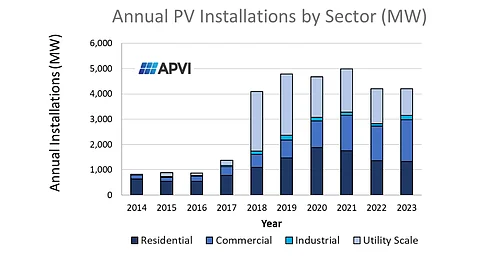

IEA PVPS report on Australia looks at the key trends and developments in its solar market in 2023
Utility-scale solar continues to grow slowly; its growth is essential for the country to meet its net-zero targets
Going forward, Australia will need to redesign tariffs to incentivize the use of low-cost, low-emissions power and also invest in storage, transmission and distribution
Traditionally a strong rooftop solar market, Australia installed 3.1 GW of new capacity on residential, commercial and industrial buildings in 2023, up from 2.8 GW in 2022, out of a total of 4.2 GW of new solar the country registered last year, according to a new International Energy Agency Photovoltaic Power Systems Programme (IEA PVPS) report.
Of the new rooftop solar installations last year, industrial deployment registered a year-on-year (YoY) increase of 73%, and commercial 21%, pointing to the continued demand growth in the decentralized sector, even though residential installations dipped by 3%.
As of March 2024, the report writers count 40% of the country’s free-standing homes to be powered by solar, and another 11.3 GW of centralized solar. This clean energy now accounts for more than 17% of the total national electricity demand.
However, it is the utility-scale segment that’s seeing a decline. According to the report, connections in this segment declined to the lowest annual install rate for 5 years with 1.05 GW, down from 2.4 GW in 2018 and 2019. The 24% YoY decline is attributed to the end of large-scale system support in 2020 under the Commonwealth Government’s Renewable Energy Target. Grid connection concerns add to the challenges for this segment.
Australia met its Large-scale Renewable Energy target (LRET) of 33,000 GWh in late 2019.
The writers recommend growth for the utility segment if Australia aims to achieve its net zero ambition by the target year of 2050. Signs of recovery are visible as the country’s 6 GW renewable energy tender under its Capacity Investment Scheme (CIS) received 40 GW of bids.
Australia’s total installed solar PV capacity at the end of 2023 reached 34.6 GW with a world-leading installation rate of over 1.33 kW of solar/person. The Netherlands has the 2nd highest solar installed/person with around 1.27 kW, followed by Germany’s 0.97 kW. Rooftop solar comprised over 22 GW of the aggregate as the report notes the country has been almost doubling its rooftop PV capacity every 3 years with 6.1 GW at the end of 2017, and 13.6 GW in 2019.
While the country continues to be among the top 10 in the world in terms of total installed capacity, in 2023 it slipped out of the top 10 for annual installations for the 1st time since IEA PVPS started tracking in the 1990s.
“At 4.2 GW the Australian market is stable, but the rest of the world is growing so we’re falling behind. Rooftop solar, particularly industrial scale, is growing,” said PVPS Executive Committee member Renate Egan. “It’s utility scale solar that has stalled and we’re going to need to see significant growth to meet our net zero ambitions. Fortunately, new state and federal government initiatives are set to address this.”
Beyond the rooftop and utility-scale segments, agriPV or agrivoltaics gain traction in this market as several trials are currently underway here. There are, however, only small activities that target BIPV, floating PV, and VIPV domains as these largely remain limited to research or demonstration scale levels.
Australia will continue to support Small-scale Technology Certificates through to 2030 which should provide momentum for rooftop solar and growth in the commercial and industrial (C&I) segments.
The future is also bright thanks to the state-supported Renewable Energy Zones (REZ) in the states that will boost large-scale installations and increase investor confidence. The country’s energy market operator AEMO is planning 100% renewable energy penetration across the national electricity market by 2025.
“The ongoing investment in renewables will present market and engineering challenges that will need to be met by policy and regulatory change, by a redesign of tariffs to incentivise use of low-cost, low-emissions power, investments in storage, in transmission and distribution,” reads the report.
Currently, the country’s sole domestic solar module manufacturer is Tindo Solar with 60 MW capacity, with plans to expand it to 150 MW. While Simcoa Pty Ltd has 50,000 tons of total production capacity for metallurgical-grade silicon, it predominantly goes to the US.
The country has no ingot, wafer, or cell production capacity presently. This should change as the federal government’s AUD 1 billion Solar SunShot initiative attracts manufacturers to invest in the country (see Trinasolar To Expand Manufacturing Footprint To Australia).
Published under Task 1 of the program, the IEA PVPS report titled National Survey Report of PV Power Applications in Australia 2023 is prepared by the Australian PV Institute (APVI). It is available for free download on its website.
